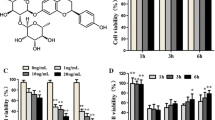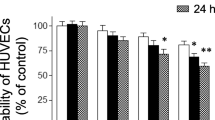Summary
Finding the novel drug from the effective components of traditional Chinese herbal medicine is a hotspot of the modern pharmacological research. Hyperoside (HYP) belongs to flavonoid glycosides, and it has various properties, such as anti-inflammation, anti-spasm, anti-diuretic, antitussive, lowering blood pressure, and lowering cholesterol effects as well as protective effects for the cardiac and cerebral blood vessels. The purpose of this study was to investigate the effects of HYP on inflammatory and apoptotic responses in vascular endothelial cells stimulated by lipopolysaccharide (LPS) and further to identify the possible mechanisms underlying these effects. In our study, human umbilical vein endothelial cells (HUVECs) were stimulated with 1 μg/mL LPS in the presence or absence of HYP (10, 20 and 50 μmol/L). Our results indicated that HYP alone exerted no cytotoxicity on HUVECs, while it had an up-regulatory effect on the viability of HUVECs induced by LPS in a dose-dependent manner; increased mRNA expression of IL-1β, IL-6, TNFα and iNOS induced by LPS was attenuated after treatment with HYP both in a dose-and time-dependent manner; LPS-induced HUVECs apoptosis and cleaved-caspase 8, 9, 3 were all significantly reduced by HYP. Furthermore, the possible pathway involved in apoptosis and inflammation by HYP was detected, and the results showed that when treated with HYP, LPS-induced mitochondrial membrane instability was significantly inhibited through up-regulation of Bcl-2 and down-regulation of Bax. Furthermore, the expression of TLR4 and the phosphorylation of IκBα and p65 in LPS-treated cells were blocked by HYP. Our results suggested that HYP treatment prevented HUVECs from LPSinduced inflammation and apoptosis responses, which might be mediated by inhibiting TLR4/NFκB pathway.
Similar content being viewed by others
References
Ross R. The pathogenesis of atherosclerosis: a perspective for the 1990s. Nature, 1993,362(6423):801–809
Allison MA, Peralta CA, Wassel CL, et al. Genetic ancestry and lower extremity peripheral artery disease in the Multi-Ethnic Study of Atherosclerosis. Vasc Med, 2010,15(5):351–359
Makó V, Czúcz J, Weiszhár Z, et al. Proinflammatory activation pattern of human umbilical vein endothelial cells induced by IL-1β, TNF-a, and LPS. Cytometry A, 2010,77(10):962–970
Wang W, Deng M, Liu X, et al. TLR4 activation induces nontolerant inflammatory response in endothelial cells. Inflammation, 2011,34(6):509–518
Tousoulis D, Andreou I, Tsiatas M, et al. Effects of rosuvastatin and allopurinol on circulating endothelial progenitor cells in patients with congestive heart failure: the impact of inflammatory process and oxidative stress. Atherosclerosis, 2011,214(1):151–157
Lopes-Virella MF. Interactions between bacterial lipopolysaccharides and serum lipoproteins and their possible role in coronary heart disease. Eur Heart J, 1993,14 (Suppl K):118–124
Kim SJ, Um JY, Lee JY. Anti-inflammatory activity of hyperoside through the suppression of nuclear factor-?B activation in mouse peritoneal macrophages. Am J Chin Med, 2011,39(1):171–181
Rylski M, Duriasz-Rowinska H, Rewerski W. The analgesic action of some flavonoids in the hot plate test. Acta Physiol Pol, 1979, 30(3):385–8.
Wen JY, Chen ZW. Protective effect of pharmacological preconditioning of total flavones of abelmoschl manihot on cerebral ischemic reperfusion injury in rats. Am J Chin Med, 2007,35:653–661
Shiraki A, Oyama J, Komoda H, et al. The glucagonlike peptide 1 analog liraglutide reduces TNFalpha-induced oxidative stress and inflammation in endothelial cells. Atherosclerosis, 2012,221(2):375–382
Lee YJ, Moon MK, Hwang SM, et al. Antiinflammatory effect of Buddleja officinalis on vascular inflammation in human umbilical vein endothelial cells. Am J Chin Med, 2010,38(3):585–598
Hayden MS, Ghosh S. Shared principles in NFkappaB signaling. Cell, 2008,132(3):344–362
Shih Vf, Tsui R, Caldwell A, et al. A single NFkB system for both canonical and non-canonical signaling. Cell Res, 2011,21(1):86–102
Liu Y, Liu H, Chen W, et al. EOLA1 protects lipopolysaccharide induced IL-6 production and apoptosis by regulation of MT2A in human umbilical vein endothelial cells. Mol Cell Biochem, 2014,395(1-2):45–51
Wan C, Chen Y, Yin P, et al. Transport stress induces apoptosis in rat myocardial tissue via activation of the mitogen-activated protein kinase signaling pathways. Heart Vessels, 2016,31(2):212–221
Tong F Lian Y, He F. Novel S-MSPQC cell sensor for real time monitoring the injury of endothelial cell by LPS and assessing the drug effect on this injury. Biosens Bioelectron, 2015,71:62–67
Ming X, Ding M, Zhai B, et al. Biochanin A inhibits lipopolysaccharide-induced inflammation in human umbilical vein endothelial cells. Life Sci, 2015,136:36–41
Author information
Authors and Affiliations
Corresponding authors
Additional information
This work was supported by a grant from the scientific and technological project of Henan province (No. 172102310531).
Rights and permissions
About this article
Cite this article
Zhou, Yq., Zhao, Yt., Zhao, Xy. et al. Hyperoside Suppresses Lipopolysaccharide-induced Inflammation and Apoptosis in Human Umbilical Vein Endothelial Cells. CURR MED SCI 38, 222–228 (2018). https://doi.org/10.1007/s11596-018-1869-2
Received:
Revised:
Published:
Issue Date:
DOI: https://doi.org/10.1007/s11596-018-1869-2




